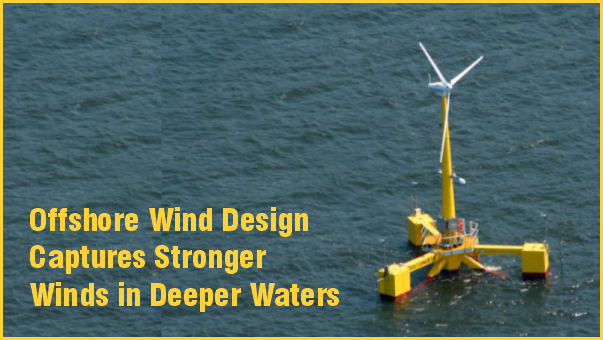Offshore Wind Design Captures Stronger Winds in Deeper Waters
Researchers seek to scale up semi-submersible floating platforms for wind farms farther from shore and in deeper water.
Floating offshore turbines can harness wind resources in waters too deep to accommodate conventional foundations attached to the ocean floor. About two-thirds of the U.S.’s offshore wind potential blows atop 196-foot depths, meeting the limit for industry-standard fixed-bottom turbines.
University of Maine engineers are developing a semi-submersible floating platform to tap the East Coast’s immense wind resource potential far out at sea. The university’s Advanced Structures and Composites Center built a 13-foot-tall, 1:70-scale model that will eventually expand to more than 700 feet with 15 to 20 MW turbines anchored via a mooring system. More than 50 engineers contributed to the demo. Recent tests in a wave pool research facility showed the turbine could generate power from strong winds while maintaining stability.

Engineers test floating offshore wind technology in an indoor pool. Image used courtesy of the University of Maine
Floating offshore wind technology is beginning to expand from the laboratory to commercial applications, with activity primarily concentrated in Europe. Over 100 GW of projects are in the global pipeline today, most in the early stages of development. In the U.S., floating designs account for about 6 GW of the total 52 GW of offshore wind projects underway, according to the Department of Energy (DOE). The federal government aims to deploy 15 GW of the technology by 2035.

Potential of fixed and floating offshore wind substructures by water depth. Image used courtesy of Department of Energy (Page 5, Figure 1)
Tradeoffs: Floating vs. Fixed-Bottom Designs
Most offshore wind turbines feature fixed bottoms secured to the sea floor by a monopile foundation or gravity base. Ideal for near-shore sites shallower than 200 feet, this design is advantageous for its strong stability, enabling consistent power generation and easy, permanent installation, which reduces maintenance costs.
Nearly 3 TW of offshore wind energy potential—enough to power 350 million homes—lies in areas inaccessible to fixed-bottom turbines. Fortunately, floating offshore wind turbines can be placed hundreds to thousands of feet beneath the surface and in areas with rough seabed conditions.
There are three popular floating wind turbine types. Semi-submersible platforms, like the University of Maine’s demo unit, are most popular because they can be deployed at depths over 131 feet while keeping the cost of the anchoring system relatively low. Semi-submersible designs are also easier to install and transport, with turbines assembled at dockside and towed out to sea. According to the DOE, about 80% of projects have opted for this design.

Floating turbine types: spar (a), semi-submersible (b), and tension leg platforms (c). Image used courtesy of the study authors (Figure 2)
Like semi-submersible foundations, spar designs incorporate mooring lines with anchors. However, they also feature a taller hull and buoyant cylinder ballasted with a deep draft, ensuring the structure stays stable in different wind and wave speeds and currents. Due to the hull height, spars are better in depths greater than 328 feet. Still, installation and transport introduce challenges for stability, making spars less popular.
Tension leg platforms (TLPs) can be deployed in waters deeper than 900 feet. A permanently moored platform attaches tethers at each corner system, providing consistent tension under different operating loads paired with the hull’s upward buoyancy. TLP systems are commonly used in offshore oil production.
European projects have proven the technical viability of floating offshore wind turbines, but several challenges remain. First, the design needs more dynamic loading conditions and components. Control systems need platform stability to limit dynamic motion. Researchers are exploring control systems to enable load reduction and innovative turbine positioning in the wind plant, boosting reliability and performance. One solution could be adding more components—like mooring lines, active ballast systems, and dynamic cables—to manage combined dynamic loads caused by wind and waves. However, more moving parts means higher operation and maintenance costs.
Scaling to a Real-World Demonstration
Several demonstrations from Portugal to Norway have proved floating wind turbines’ key strengths. The University of Maine is a critical player in the U.S.’s effort, with its 400-person engineering center and leading innovations in concrete foundation technology. The Advanced Structures and Composite Center hosts a vital research tool: Its 1:50-scale model testing facility simulates variable water depths and multi-directional wave conditions seen in the world’s most powerful storms.
The Gulf of Maine has the most consistent wind speeds on the East Coast, an advantage the state government considered when it set a goal to procure up to 3 GW by 2040. Last year, Maine’s governor proposed a research array at a 15.2-square-mile site in federal waters. About 10 to 12 turbines will be installed on a semi-submersible floating concrete platform, VolturnUS, designed by the Advanced Structures and Composite Center.
This marks an expansion of Volturn’s previous capabilities. A decade ago, the University of Maine installed a 6 MW version with 50 onboard sensors. Since then, the unit has survived over 40 extreme events, including 500-year storms, with minimal acceleration in all cases.

VolturnUS. Image used courtesy of the University of Maine
A higher-capacity, single-turbine demonstration has been under development since 2020, and cable work and construction are scheduled to begin this year. The 11 MW VolturnUS-based New England Aqua Ventus I unit will be the first industrial-scale floating wind system in the U.S. The project will mount the turbine onto the VolturnUS floating semi-submersible concrete hull, held in position by three mooring lines anchored to the seabed. It will connect to Maine’s power grid through a subsea cable.
VolturnUS boasts several unique construction features centered around the choice of concrete rather than steel. Concrete offers high corrosion resistance and a longer design life, reducing operation and maintenance needs. The platform is also heavier than a comparable steel system, with a low center of gravity and high buoyancy.
VolturnUS’s rectangular bottom beams are easier to build and more resistant to wave motion than cylindrical designs.

